IB Biology HL (HIGHER level)- 2024 – Practice Questions- All Topics
Topic 10.1 Meiosis
Topic 10 Weightage : 10%
All Questions for Topic 10.1 – Interphase, Stages of Meiosis, Random Assortment, Chiasmata, Crossing Over, Drawing Meiosis, Meiosis vs Mitosis, Stages of Prophase, Mendel and Meiosis
Question
Which statement is valid regarding chromatids?
A Sister chromatids separate during meiosis I.
B Chiasmata form between non-sister chromatids.
C Crossing over is the exchange of DNA between sister chromatids only.
D Non-sister chromatids have the same combination of alleles.
▶Answer/Explanation
Ans: B
Chiasmata, refer to the physical crossover points or locations where genetic material exchanges occur during the process of crossing over in meiosis. This genetic exchange transpires between non-sister chromatids of homologous chromosomes. The actual crossing over happens during the prophase I stage of meiosis, where non-sister chromatids of homologous chromosomes align and intertwine. At specific junctures along their length, the chromatids rupture and exchange segments of genetic material.
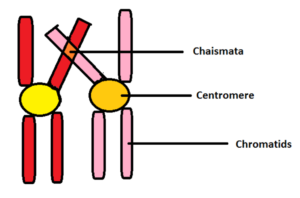
Once crossing over is complete, the chiasmata resolve, and the non-sister chromatids separate, ensuring that the final gametes contain a unique combination of genetic material from the original parent cells. Sister chromatids, on the other hand, remain joined together until they separate during anaphase II of meiosis.
The formation of chiasmata between non-sister chromatids promotes genetic recombination, leading to increased genetic diversity among the resulting gametes.
The genetic determination of dogs’ coats can be quite complex, with many different genes acting at the same time.
• The dominant allele E gives brown tones. The recessive allele e results in red tones.
• The colour intensity is due to another gene. The dominant allele B gives a dark colour, whereas the recessive allele b results in a light colour.
What would be the genotype of a light brown dog produced from a cross between a dark brown dog and a light red dog?
A. EEbb
B. EeBb
C. eeBb
D. Eebb
▶Answer/Explanation
Ans: D
To determine the genotype of a light brown dog produced from a cross between a dark brown dog and a light red dog, we can use the given information about coat color genetics.
E: Dominant allele for brown tones
e: Recessive allele for red tones
B: Dominant allele for dark color intensity
b: Recessive allele for light color intensity
Two possible combinations form: BBEE × bbee
BbEe × bbee
BE | Be | bE | be | |
Be | BbEe | Bbee | bbEe | bebe |
Be | BbEe | Bbee | bbEe | bebe |
Be | BbEe | Bbee | bbEe | bebe |
Be | BbEe | Bbee | bbEe | bebe |
BbEe – dark brown dog
Bbee – Dark red dog
bbEe – light brown dog
bebe – light red dog
Combining the possibilities for coat color and intensity, we find that the only genotype consistent with a light brown dog is Eebb.
Which gametes can result from the following crossover?
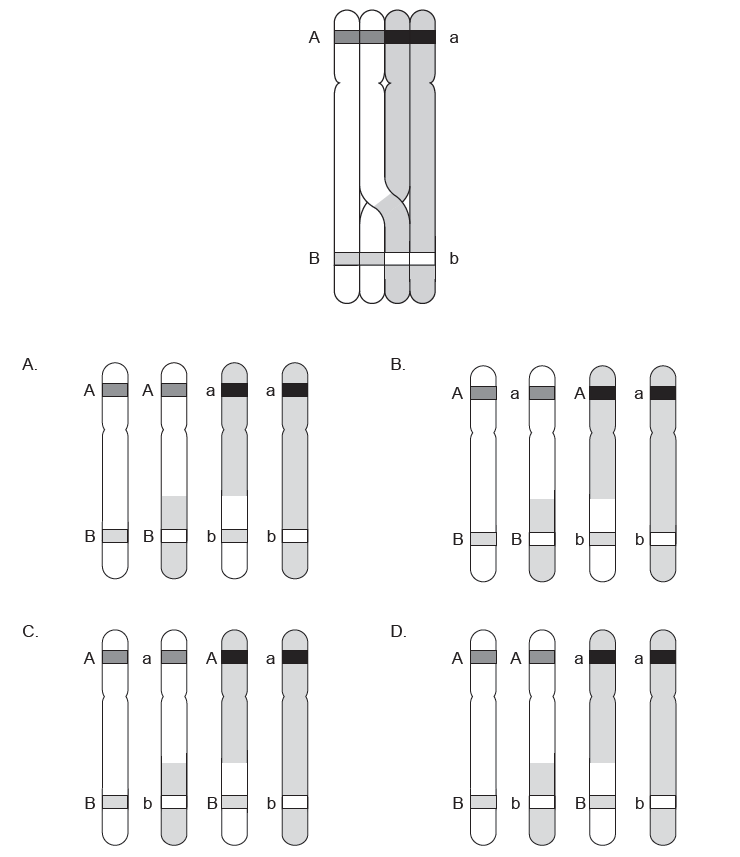
▶Answer/Explanation
Ans: D
The crossover process occurs during meiosis and involves the exchange of genetic material between homologous chromosomes. In the case of the crossover pattern AaBb, it indicates that there are two gene loci (A and B) with two different alleles (a and b) each.
Two of the four daughter cells formed after this crossing over event have a recombinant chromosome that is neither completely derived from the mother nor the father.
In the case of AaBb, the possible gametes that can result from crossover are:
AB: This gamete would contain the A allele from one parent and the B allele from the other parent.
Ab: This gamete would contain the A allele from one parent and the b allele from the other parent.
aB: This gamete would contain the a allele from one parent and the B allele from the other parent.
ab: This gamete would contain the a allele from one parent and the b allele from the other parent.
So, the four possible gametes resulting from the crossover pattern AaBb are AB, Ab, aB, and ab as mentioned in option D.
In which situation are alleles exchanged?
A. During the separation of sister chromatids
B. In the transmission of linked genes
C. During fertilization when sperm and egg chromosomes pair up
D. When chiasmata are formed between non-sister chromatids
▶Answer/Explanation
Markscheme
D
When chiasmata are formed between non-sister chromatids during meiosis, alleles can be exchanged through a process called genetic recombination or crossing over. Chiasmata are physical connections that occur between homologous chromosomes during prophase I of meiosis.
During meiosis, homologous chromosomes pair up, and each chromosome consists of two sister chromatids. Chiasmata occur at points along the paired homologous chromosomes where genetic material is exchanged. These exchanges happen between non-sister chromatids of the homologous chromosomes. The exchange of genetic material between non-sister chromatids leads to the swapping of alleles between homologous chromosomes. Alleles are different versions of a gene that determine specific traits. Each homologous chromosome carries different alleles for the same genes.
When chiasmata form and crossing over occurs, the genetic material between non-sister chromatids is broken and exchanged. This exchange can result in the transfer of different alleles between homologous chromosomes. As a result, the offspring may inherit a combination of alleles from both parents that differ from the original combination.
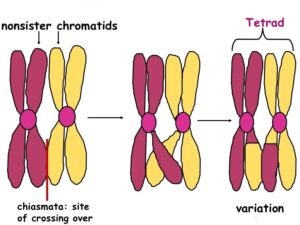
At which stage of meiosis does a pair of sister chromatids separate?
A. Metaphase I
B. Anaphase I
C. Metaphase II
D. Anaphase II
▶Answer/Explanation
Markscheme
D
During Anaphase II of meiosis, the paired sister chromatids, which were created during meiosis I, separate and move towards opposite poles of the cell. Anaphase II is the third stage of meiosis II, following prophase II and metaphase II.
During Anaphase II, the spindle fibers contract, pulling the sister chromatids apart. The connections holding the sister chromatids together, known as cohesion, are broken down, allowing each chromatid to move toward opposite poles of the cell.
At the end of Anaphase II, each pole of the cell contains a complete set of chromosomes, with one chromatid from each pair. This is the final step before the cell proceeds to telophase II and cytokinesis, resulting in the formation of four haploid daughter cells, each containing a unique combination of chromosomes.
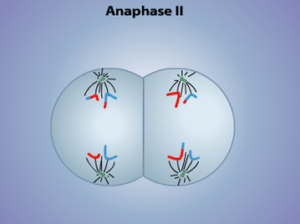
How does meiosis cause Mendel’s law of independent assortment?
A. Linked genes are randomly separated.
B. The chromosome number is divided twice.
C. Crossing-over occurs in Anaphase I.
D. Alleles that are not in the same linkage group are segregated.
▶Answer/Explanation
Markscheme
D
When alleles are located on different linkage groups, they are said to be on different chromosomes. In such cases, during meiosis, the chromosomes segregate independently of each other. This is known as independent assortment. Mendel’s Law of Independent Assortment, also known as the Second Law of Mendelian Inheritance, describes the random segregation and independent assortment of alleles for different traits during gamete formation.
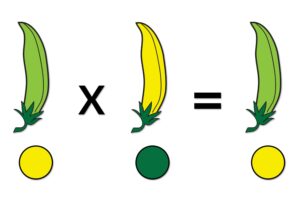
Independent assortment occurs because homologous pairs of chromosomes align randomly during meiosis I, and the separation of each pair is independent of the separation of other pairs. As a result, the alleles on different chromosomes can assort and recombine in different combinations.
This independent assortment of alleles on different chromosomes contributes to genetic diversity in offspring. It allows for the creation of new combinations of alleles through the shuffling of genetic material during meiosis and contributes to the inheritance patterns observed in genetics.
The diagram below shows chromosomes during meiosis.

How many chromosomes and chiasmata are visible?
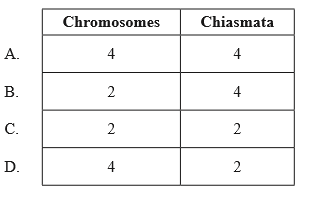
▶Answer/Explanation
During meiosis, the process of cell division leads to the formation of gametes i.e., sperm and eggs, during this process, chromosomes undergo specific changes. There are 2 chiasmata and 2 in the given diagram.
In a chromosome during meiosis when there are 2 chiasmata and 2 chromosomes, it signifies a specific stage of meiosis called Metaphase I. During Metaphase I, the paired homologous chromosomes, each consisting of two sister chromatids, align at the equator of the cell. At this stage, each homologous chromosome pair has formed a chiasma. Therefore, if you can see 2 chiasmata, it suggests that you are observing two homologous chromosome pairs, resulting in 2 chromosomes in total.